Putting themselves on the line: Activists say nonviolent protests focus attention, inspire others, drive change
| Published: 03-28-2025 4:20 PM |
Valley residents have been witnessing growing numbers of their neighbors standing out in the rain, wind and cold toting colorful signs and passionate messages.
From sit-ins in the lobby of L3Harris in Northampton protesting the company’s sale of military equipment being used against Palestinians, to a weekly gathering by pro-Palestinian activists at the rotary near the Coolidge Bridge in Northampton, and stand-outs protesting the closure of the U.S. Fish & Wildlife headquarters in Hadley, there has been no shortage of residents making their voices heard.
While the immediate goals of each group or form of protest may differ, the citizens involved in these acts of resistance resoundingly agree that nonviolent action is the most effective way of bringing about change.
David Howlett, a visiting assistant professor of religion at Smith College who teaches a course titled “Nonviolent Protest,” described nonviolent resistance as “one of the simplest and most effective tactics people have for creating change.”
Howlett noted that nonviolent resistance is not limited to the traditional protests one might see on the sidewalks of their town. This kind of protest can take on many less visible forms as well, such as providing mutual aid or striking from work. But the success of these various forms of protest comes from the coalitions that are formed across communities, and even across countries.
“Small groups alone don’t often make big differences,” said Howlett. “But small groups with other small groups with other small groups often do.”
Andrea Ayvazian, a local pastor, activist and founder of the Sojourner Truth School for Social Change Leadership, seconded the idea that rallying the collective into action is essential for real, lasting change. Having been arrested over a dozen times for civil disobedience in her 73 years, Ayvazian said that, while arrests are sometimes a part of nonviolent actions, they are not the goal. Rather, arrest is a risk taken in service of a movement’s ultimate goal: enacting change.
“When we choose to create change through our witness by using nonviolent direct action, and risk arrest in the process, we do not measure success by numbers or by assuming our one action will directly lead to policy change,” Ayvazian said in an email. “We recognize that movements for change involve many actions, protests, rallies, vigils, and teach-ins. We also believe that civil disobedience creates pressure on policymakers and moves others to deepen their own commitment to act on behalf of what is just, fair, equitable, and peaceful. ”
Article continues after...
Yesterday's Most Read Articles
When issues that concern citizens loom large, taking on a national or even international scale, feelings of hopelessness often arise in the population. Common rhetoric surrounding this hopelessness usually involves people feeling that their individual action won’t have any impact, or looking askance at neighbors who stand out with their signs and rallying cries, questioning how much change their protests can truly create.
Like many of the nonviolent activists interviewed by the Gazette, Ayvazian acknowledged how pervasive those feelings can be when people perceive large-scale injustice.
“Those feelings are natural,” she said. However, she remarked that “the antidote to this sense of hopelessness is not to tune out, turn away, or retreat. The antidote is to realize that movements for change are made up of many many seemingly small actions that accumulate over time.”
Nick Mottern, a member of Demilitarize Western Mass who has been involved in local protests of L3Harris — a publicly traded aerospace and defense contractor with an office in Northampton — said that for him, nonviolent protest is all about appealing to the consciences of his fellow community members.
“You’re interrupting the routine of life around you to point out how serious an issue is,” Mottern said.
Demilitarize Western Mass has engaged in multiple protests at L3Harris’ Northampton office over the Israel-Hamas war surrounding the company’s provision of equipment to the Israeli military. These protests have included early-morning standouts as employees enter the building, blocking an office entrance with a boat, blockading a gate with a truck full of cement, and staging a sit-in in the lobby that resulted in the arrests of five members — including Mottern — earlier this month.
“It sends a message to everybody else that there’s something going on here,” Mottern said, noting that educating the public about the issue at hand is one of the primary goals of these protests.
Mottern has viewed these protests at L3Harris as successful, as they have made more people aware of the company’s presence in the city, and what they do.
“The more we can appeal to people’s consciences and their intellect, the more we can have positive change that is enduring,” he said.
The ultimate goal of these protests, Mottern said, is bringing about changes in policy and corporate behavior. But the road to achieving that goal is paved with public education and mobilization.
“In this country, we have to really look at ourselves as participants in our own future in a full way,” said Mottern. “The age of couch potato politics is over.”
Members of other local advocacy organizations had similar stances.
“Short term, we want to wake up the population … to know that right in our backyard there is this big corporation engaging in these criminal behaviors,” said Paki Wieland — a member of Western Mass CodePink and one of the L3Harris protestors arrested alongside Mottern earlier this month — referring to L3Harris. “Long term, we want a whole different kind of economy.”
This new economy, she said, would be built around a higher quality of life for everyone, rather than violence and corporate gain. But Wieland said getting to that point will require a loud collective voice speaking out for change.
“The legislative change will come if the people demand it,” she said, later adding that “if we don’t speak out, we’re complicit in what’s happening.”
The Amherst League of Women Voters has also been making a concerted effort to speak out lately, particularly against actions taken by the Trump administration. Member Cynthia Brubaker observed that nonviolent action “takes a short view and a long view.”
“It takes more than just protesting, it’s a long process,” said Brubaker. “Protest is one way of people showing their dissatisfaction, their frustration. They want to feel hopeful.”
For Brubaker and the League of Women Voters in Amherst, a major goal of nonviolent demonstrations is mobilizing community members to engage in sustained advocacy for change once they go home from the protest. Typically, Brubaker said, the group tries to include a motivational speaker at their gatherings to spark collective hope and action.
Likewise, Beth Lev, who is on the steering committee for Indivisible Northampton — Swing Left Western Mass, said the group’s protests aim to increase visibility around certain issues, and show concerned citizens that “they’re not alone in their concern for the issue.” These protests include stand-outs protesting the closure of the Fish & Wildlife headquarters in Hadley and demonstrations on the Interstate 91 overpass in Holyoke protesting President Donald Trump’s actions since taking office.
These protests, she said, are not only about encouraging citizens to speak out and mobilize, but also signaling to local politicians that their constituents are passionate about the issues.
“It will give them more strength to take even bolder stances,” Lev said.
At the recent protest outside of Fish & Wildlife in Hadley, this desire to encourage politicians to take action abounded.
“We need to build the momentum of all of these protests. There’s been so many around, and we need to get to 3½ percent,” former educator Nancy Jessup said as she participated in the Hadley protest.
Jessup was referring to the 3.5% rule, born out of research by Harvard political scientist Erica Chenoweth showing that it takes about 3.5% of the population actively participating in resistance to produce sweeping political change. Chenoweth’s research is regarded by many as showing that nonviolent resistance is by far the most powerful way to shape world politics.
“There’s a study on authoritarianism out of the Harvard Kennedy School of Government that said when 3½ percent of the population goes out and protests authoritarian governments throughout history, they’ve all fallen. I am actively trying to recruit on the daily to get more people and build momentum,” Jessup said.
Another member of Indivisible Northampton — Swing Left Western Mass, Marta Lev, echoed these sentiments, saying that the group’s protests are all about building collective force and signaling to politicians that “we want them to resist” certain policy decisions.
“We want them to know that they need to have courage,” Marta Lev said of politicians, adding that standing out with signs is only one way the group works to spread their message. Lev also said that sending letters and emails to local decision-makers, or calling their offices, can also have an impact on their stances and actions.
A protester and member of the Unitarian Society of Northampton and Florence attending the Hadley Fish & Wildlife standout, Teresa Amabile, expressed this sentiment as well.
“I hope to give courage to the judges and the legislators who can help us out of this mess. And I’m talking about the judges and the legislators at all levels of government,” said Amabile. “I’m hoping to give them courage, and I’m hoping to lend courage to the millions of Americans who are disgusted with what’s going on.”
Marta Lev also noted that she feels the group’s messages have been gaining traction, with a crowd of dozens showing up to stand in the rain in support of Hadley Fish & Wildlife employees, and Sen. Ed Markey attending one of the group’s stand-outs in Northampton.
Taking a slightly different view, Molly Aronson, a member of the western Massachusetts chapter of Jewish Voice for Peace — which has been involved in local protests and marches in solidarity with Palestinians — said protests work by asking community members to ask themselves who holds power in a situation.
For example, Aronson said that the protests at L3Harris in Northampton have been asking the public to think about “who has the power to make sure that our city isn’t aiding and abetting war crimes, and turning people out to realize that we can make that change.”
Through her involvement with the local pro-Palestinian movement, Aronson has been attempting to learn from Palestinian resistance movements and find ways to apply their “resilience” and “persistence” to local causes.
A large part of that, she said, is “alerting people to the fact that we as a collective have an enormous amount of power … more power than a government will ever have.”
Gazette staff writer Emilee Klein contributed reporting. Alexa Lewis can be reached at alewis@gazettenet.com.

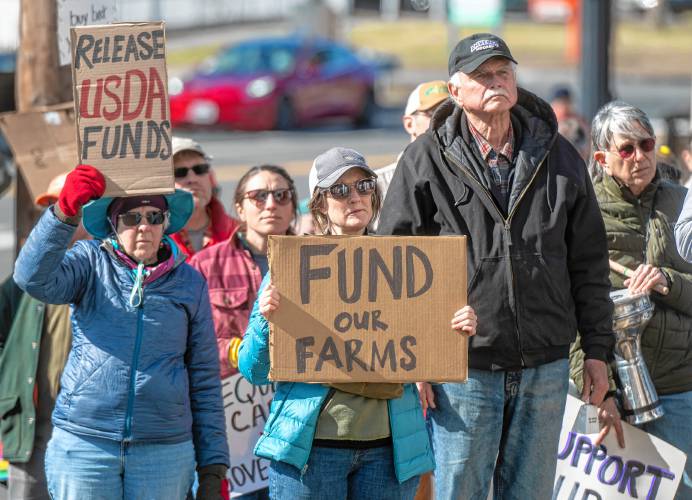
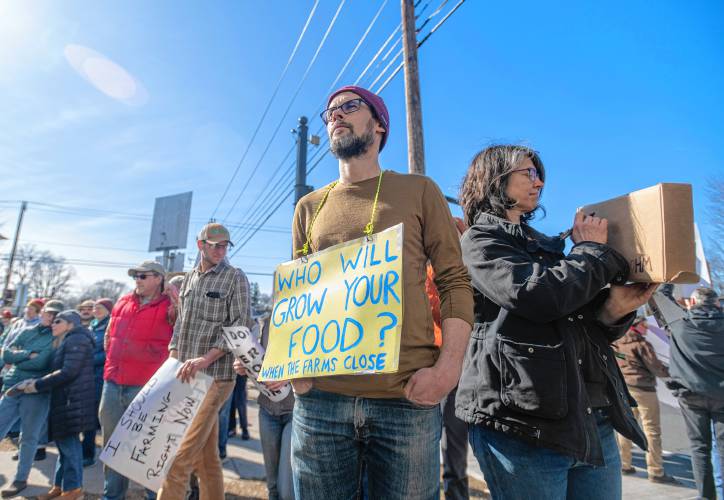
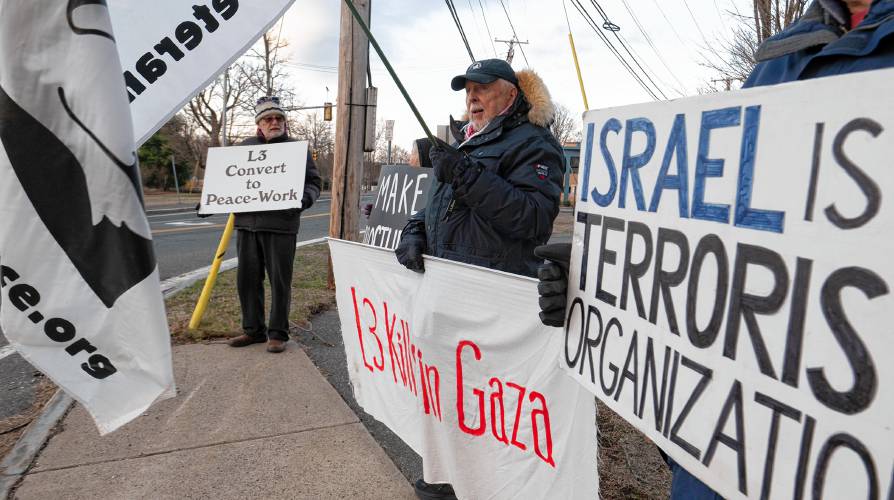





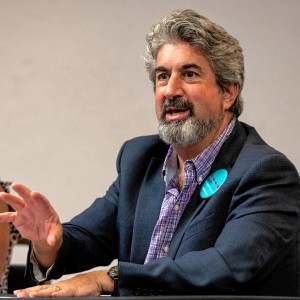 MTA president offers ways for legislators to address ‘unprecedented dangers’ to K-12 education in state
MTA president offers ways for legislators to address ‘unprecedented dangers’ to K-12 education in state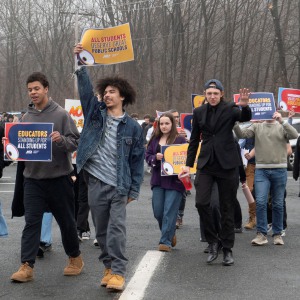 Nearly all of South Hadley High’s student body holds ‘walkout to walk-in’ rally to oppose cuts, call for funding reform
Nearly all of South Hadley High’s student body holds ‘walkout to walk-in’ rally to oppose cuts, call for funding reform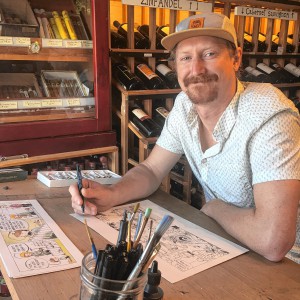 ‘Wallace the Brave’ tumbles onto Gazette comics page
‘Wallace the Brave’ tumbles onto Gazette comics page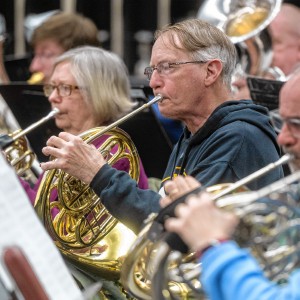 ‘For the love of music’: Florence Community Band set to hold first-ever multigenerational concert
‘For the love of music’: Florence Community Band set to hold first-ever multigenerational concert
